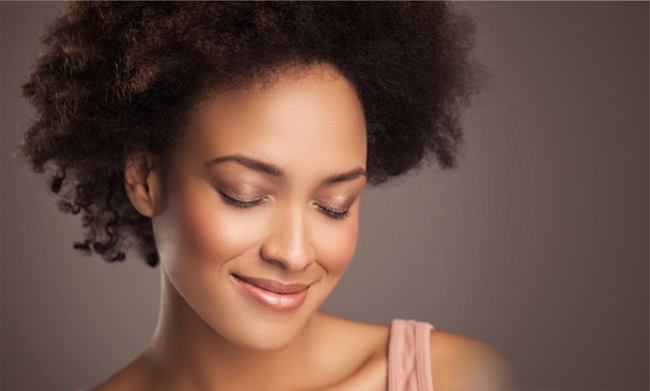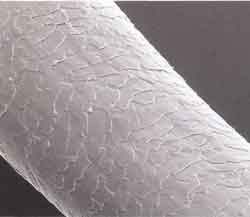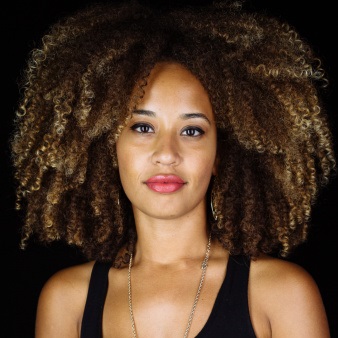
There is a problem that is afflicting a lot of new naturals which may be affecting you too. The problem is so intricate that it causes you to go down a rabbit hole of contradicting information trying to find something that ultimately will make little difference to your hair. The problem is trying to figure out your hair type.
Yes, if you visit the multitude of forums and blogs out there, a variety of women are obsessing over what their hair type is, trying to categorize themselves neatly with a letter and number in the hopes that it will open the door to a world of knowledge about how to care for their tresses.
Unfortunately these women are on a wild goose chase because the curl type chart as was initially written related to the SIZE of the curls and not much else.
There have now been entire industries created around matching naturals with products based on the letter and number system and the results are unsurprisingly hit and miss as a whole. The problem is that curl size does not really account for the variety within similar curl patterns.
There are 4a’s with silky texture and those with cottony textures. There are 4b’s with high porosity hair and those with low porosity. And there are 4c’s with thick coarse strands and those with thin strands. And to add to the variety, there are also ladies with a mix and match of these individual properties, not to mention those with a variety of curl patterns throughout their heads. Confusing huh?
Last week I got the following email from one of our readers: “Please help! I have 4BC hair. It is not retaining moisture mainly on the ends. I’ve tried everything under the sun. What should I do at this point?”
It is sad that a great number of the emails that we get from those who are just rediscovering their natural hair relates to their hair being dry without a solution that actually works. What this tells me is that there are a whole lot of natural out there who are not having much success retaining length.
Hair’s moisture levels are very intimately tied in to your hair’s porosity levels which also tie in to the thickness of your strands. Moisture as you already know is vital at keeping hair’s elasticity levels ideal, preventing breakage and keeping your hair feeling soft.
 The main culprit? POROSITY. A pore is a gap/hole in the fibre of your hair that both allows fluids in and out of the innermost layers of your strands. Because of the natural curls in afro textured hair, the cuticles on the curvature of the hair when in it’s natural state usually remain open so a higher level of porosity is observed.
The main culprit? POROSITY. A pore is a gap/hole in the fibre of your hair that both allows fluids in and out of the innermost layers of your strands. Because of the natural curls in afro textured hair, the cuticles on the curvature of the hair when in it’s natural state usually remain open so a higher level of porosity is observed.
With relaxed hair, porosity is increased during the relaxing process because of the high alkalinity of the relaxer. This means that relaxed hair will as a whole tend to be higher porosity than natural hair.
Other factors that increase porosity are bleaching, mechanical damage or even exposure to sunlight. Under a microscope you will often find that the ends of long hair (which have had the most exposure to sunlight) will be completely devoid of cuticles! They have either worn away or fused together, and this is before taking into account any mechanical or chemical damage.
On the other end of the scale are those with low porosity hair usually but not excluded to those with thicker strands. Low porosity hair tends to maintain a certain level of moisture not letting much in and not allowing much out either. This would be an ideal situation if the moisture level was higher in order to increase the hair’s elasticity but natural hair will tend to have lower moisture levels which leads to the hair feeling coarse and dry despite conditioning.
The solution? PICK THE RIGHT PRODUCTS. We talk more about porosity and how to get your hair to an appropriate level in this article here but it is important to realize that depending on your own porosity levels, the products that you choose should change.
It is fascinating to see how some segments of the natural community can rave about how great a product is while others find that it does not work very well for them at all. For instance, the popular Cantu Shea Butter Leave In is a popular product used by many naturals.
Some swear by it saying it keeps their hair soft and hydrated while others say that it is never absorbed and leaves white flakes all over their hair. This may be easily explained by major differences in porosity rather than a specific hair type. High porosity hair tends to absorb product while low porosity strands repel them.
 What to do when high porosity hair does not hold on to moisture
What to do when high porosity hair does not hold on to moisture
When it comes to caring for your hair, once you have determined your porosity, those with high porosity strands should concentrate on heavy oils, butters and conditioners. Try to prevent excessive uptake of water by prepooing with oil before each wash and seal with a suitable mid to heavy oil.
Some products are created specifically for high porosity hair like the popular Roux Porosity Control* line of products so you may want to give those a try too.
Coconut oil* is great for prepooing because it penetrates the hair and prevents the strands from swelling when wet but you may find that it is not the best at sealing your high porosity strands.
The take home message is to deep condition using a thick heavy products that contain plenty of oil (you can add and extra shot of oil to your conditioners to make them richer) and use the LOC method to seal your hair afterwards. You may also find that you need to add some moisture to your hair daily or every other day to maintain ideal levels.
What to do when low porosity hair does not hold on to moisture
For those with low porosity strands the idea is to increase your hair’s porosity levels by deep conditioning* with heat or steam to allow the cuticles to open and allow moisture inside. Choose light conditioners over the heavier ones and seal with appropriate light oils* like jojoba*.
While there is no rule that says that you cannot use heavy oils or butters* when you have low porosity hair, it is important to note that your hair type makes you more susceptible to build up which worsens moisture levels over time.
For this reason cleansing with shampoo weekly or at least every 10 days is advisable and co-washing should not be done regularly until your porosity levels have cycled down to a normal level.
With low porosity hair the take home message is not to coat your strands with excessive oils* or heavy butters* for extended periods, use heat to deep condition and clarifying your hair periodically.
In closing…
There is a reason why here on BHI we stress that knowing your own hair and building a solid regimen is the best way to guarantee healthy hair in the long term. While knowing if you are a 3c or 4c may point you in the right direction of what products you can try, not everything that is recommended may work on your particular head of hair.
looks nice
I have tried hair lotions,and kinky curls products but I stop,and just oil my hair with castor oil that seems to help my hair 4b/c type.
I did my big chop 8-6-14 before that I transition for 4 months but for the last couple of months my seems as if it’s not holding moisture and is very dry. I use the LOC method every night. I did switch over to the shea moisture collect because I’m trying to find a regiment for my hair . Now I just feel completely lost on what I’m doing. Please help!
Alma I thought the Roux hair products where for people who had low porosity stands???
I myself have 4b, low porosity hair and I have been on my Journey for at least two years and my hair is only a collar bone length, am learning as I go how to care for my hair and with only one set back, I can honestly say I still need a regiment or to know what products are good for my type, please advise., thank you for this topic and need more.